How to Fix Error Code 0x643 on Windows 10
Some Windows 10 users are encountering the 0x643 (The software change returned error code 0x643) when attempting to install a 3rd party application. The problem is prevalent but not exclusive to using SCCM (System Center Configuration Manager) to deploy a program on several computers at once. This issue is most commonly reported with Adobe products (Lightroom, Illustrator, Photoshop, etc. ) and with Office products (Word, Excel Powerpoint, etc.).
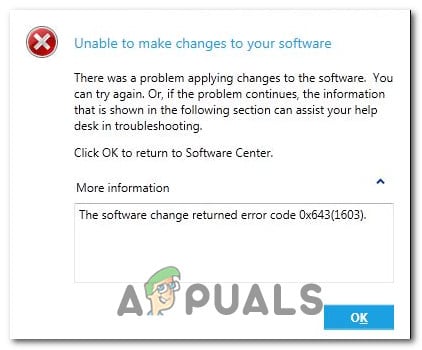
After investigating this particular issue thoroughly, it turns out that there are several different underlying causes that might be causing this particular error code. Here’s a shortlist of potential culprits that might be causing the 0x643 error code:
- Improper Command Line Interpreter path – In case you see this error while attempting to use the SCCM utility to deploy a program on multiple computers, you might be dealing with this issue if the command line interpreter is expected in a different path by SCCM. In this case, you can resolve the issue by using COMSPEC to rectify the erroneous location to the correct one.
- Corrupted .NET dependencies – Depending on the program that you want to deploy via SCCM, you might expect to see this error due to some corrupted .NET Framework dependencies that are required by the software you are trying to install. In this case, you should be able to fix the issue by running the .NET Repair tool and applying the recommended fix.
- .NET Framework 3.5 / .NET Framework 4.8 is disabled – There are a series of .NET packages that come preinstalled on Windows 10 computers. These are crucial to a lot of program installations including Adobe and Microsoft products. If this scenario is applicable, you might be able to fix the issue by ensuring that both built-in .NET frameworks are enabled.
Now that you are familiar with every scenario that might be causing this error, here’s a list of methods that other affected users have successfully used to get to the bottom of this issue:
Method 1: Pointing to the Command Line Interpreter (via COMSPEC)
If you’re encountering this issue while attempting to use the SCCM utility to deploy a program on multiple computers, you should precede this process by using the COMSPEC utility to point towards the correct path of the command line interpreter.
Several affected users have reported that they managed to fix this issue by running a COMSPEC command inside an elevated command prompt prior to deploying the program via SCCM.
If you’re looking for specific instructions on how to do this, follow the instructions below:
- Press Windows key + R to open up a Run dialog box. Next, type ‘cmd’ inside the text box and press Ctrl + Shift + Enter to open an elevated Command Prompt with admin access. When you are prompted by the UAC (User Account Control), click Yes to grant admin access.

Opening up an elevated Command Prompt - Inside the elevated command prompt, type the following command and press Enter to specify the correct path for the command-line interpreter:
COMSPEC="C:\WINDOWS\COMMAND.COM
- Once the command has been processed successfully, jump back into the SCCM utility and resume the deployment of the applications that were previously failing with the 0x643 error code.
If this method didn’t allow you to resolve the error code, move down to the next potential fix below.
Method 2: Running the .NET Repair Tool (if applicable)
If you’re encountering issues while attempting to install an Adobe product, chances are the 0x643 error is thrown due to an inconsistency with the .NET framework.
It’s not uncommon for the SCCM utility to fail due to remnants of an old .NET framework installation or due to a bad update that was partially installed.
Some users that were also dealing with this error when attempting to deploy Adobe products have reported that they finally managed to prevent new instances of the ‘software change returned error code 0x643′ from occurring by running the .NET Framework Repair Tool –
Note: This tool will automatically scan your computer and fix any .NET dependencies that might be creating issues.
In case you haven’t tried running the .NET Repair tool, follow the instructions below for these step by step instructions to receive step-by-step guidance on how to run this utility:
- Open your browser and access the Microsoft .NET Framework Repair tool download page.
- Next, click on the Download button under the Microsoft .NET Framework Repair Tool.

Running the .NET Repair tool - Once you get to the next screen, start by checking the box associated with NetFxRepairTool.exe while ensuring that you uncheck everything else.
- Next, click on Next to advance to the next menu of the NetFXRepair Tool.
- After the download is complete, double-click on the installation executable that you’ve just downloaded, then click Yes when prompted at the UAC (User Account Control).
- After the download is complete, double-click on the executable that you’ve just downloaded and click Yes at the UAC prompt to grant admin access.
- Once you’re finally inside the Microsoft .NET Framework Repair Tool, follow the on-screen instructions and check the box associated with I have read and accepted the license terms when prompted by the ToS before clicking on Next to move forward.
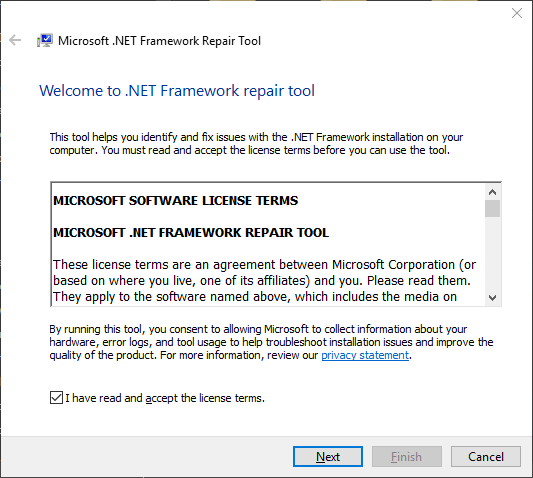
Accepting the EULA - A short while after you agree with the EULA, the utility should have already begun the scanning of the .NET dependencies installed on your computer.
- Wait patiently until the process is complete then click on Next to automatically apply the repair strategy that the utility recommends.
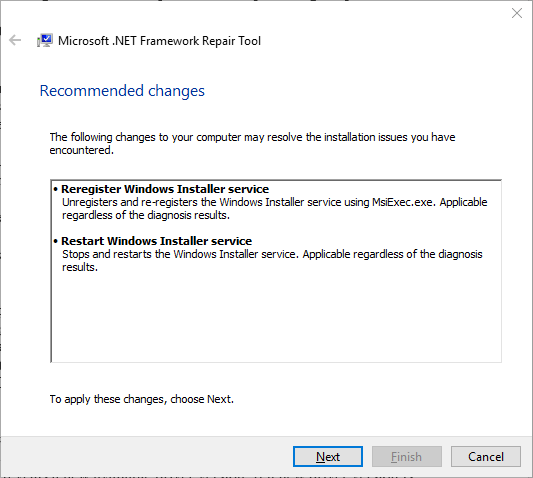
Repairing the NET framework - Finally, after the fix is successfully applied, click on Finish to complete the process.
Note: In case you’re not prompted to restart automatically, do it yourself and see if the error code 0x643 is resolved the next time you attempt to install a new .NET Framework version.
If you already ran the .NET Framework Repair utility and you’re still seeing the same error, move down to the next potential fix below.
Method 3: Enabling .NET Frameworks 3.5 and 4.8 (if applicable)
If repairing the existing .NET framework didn’t allow you to resolve the 0x643 error code, you should also consider that the installation of the program fails due to an existing .NET framework that is correctly installed but it’s disabled from the Programs and Features menu on the computer that it needs to be deployed on.
Most commonly, affected users have reported that in their case, the error occurred because the pre-installed .NET frameworks 3.5 and 4.8 were disabled so the installation was not able to complete.
In this case, you should be able to avoid the error altogether by enabling the framework directly from the Windows Features screen.
Follow the instructions below to ensure that the .NET Framework 3.5 and .NET Framework 4.8 Advanced Services are enabled from the Windows Features screen:
Important: If you are encountering the issue with multiple computers, you need to follow the instructions below will every affected machine.
- Open up a Run dialog box by pressing Windows key + R. Next, type ‘appwiz.cpl’ inside the text box and press Enter to open up the Programs and Features menu.
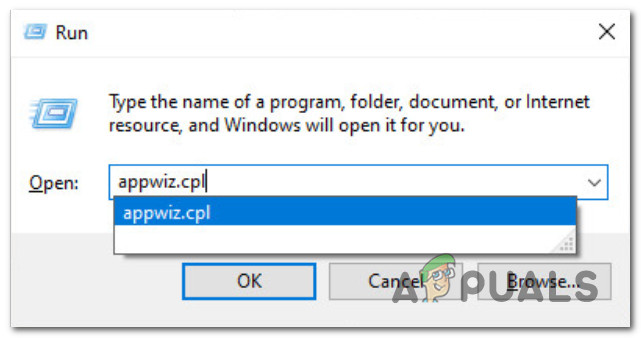
Opening appwiz - Once you’re inside the Programs and Features menu, use the menu on the right to click on Turn Windows features on or off.
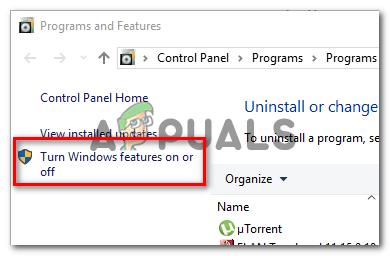
Turning on the Windows Features screen - Inside the Windows features screen, start by checking the box associated with .NET Framework 3.5 (this package includes .NET 2.0 and 3.0), then click Ok to save the changes.
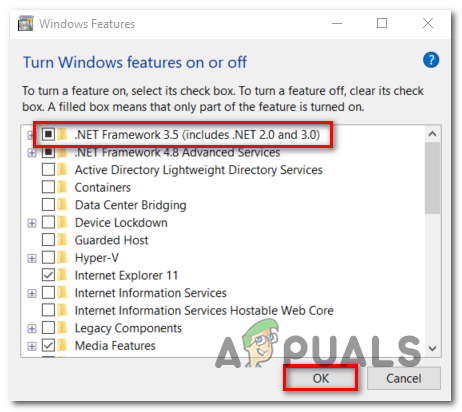
Enabling the .NET framework 3.5 - At the confirmation prompt, click Yes to initiate the procedure, then wait for the package to be successfully installed.
- Next, repeat steps 3 and step 4 with the .NET Framework 4.8 Advanced services.
- Once both operations are complete, reboot your computer and see if the problem is fixed once the next startup is complete.




